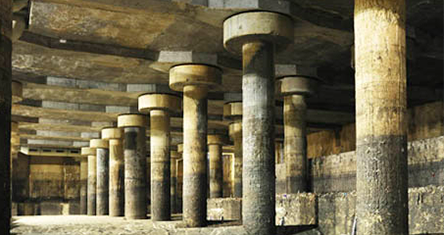STORM TANKS: DEFENDING OUR RIVERS
DE MADRID Y DEL GRIFO
In our blog you will find tips to save water and learn how we work to convey it with the best quality to your tap in Madrid
DE MADRID Y DEL GRIFO
In our blog you will find tips to save water and learn how we work to convey it with the best quality to your tap in Madrid
Suscríbete al blog
STORM TANKS: DEFENDING OUR RIVERS
Storm tanks play an essential role: they store the first rainwater and regulate its flow into the treatment plants

We’re used to seeing water pour down from the sky soaking the streets. But when the torrent goes down into the sewers, where does it end up? As a general rule, in wastewater treatment plants. But in Madrid, we have a system that allows us to retain rainwater in storm tanks before it reaches the treatment plants.
Storm tanks are huge underground tanks designed to store the first rush of rainwater, which is also the most polluting –even more than sewage– because it carries away all the dirt accumulated on streets and pavements. In this way, these tanks prevent treatment plants from becoming overloaded and having to discharge excess untreated water into receiving watercourses.
On days of heavy rainfall, water runs down through the drains, but due to the huge volume it cannot be purified immediately. So, these waters are held in the storm tanks until the rain stops. That’s when it’s gradually fed into the purification plants. This not only prevents it from polluting the rivers but also prevents flooding and environmental damage.
The water is channelled into the storm tanks through huge collectors which can be up to six metres in diameter, like underground tunnels. But before it reaches the tanks, the water passes through a series of filters that can catch solid contaminants like plastic bottles and other objects. Many of the solid objects that reach the tank with the rainwater settle at the bottom of the tank. These are removed later by different cleaning systems.
Canal de Isabel II has 65 storm tanks that capture rainwater before it’s treated. Together they can store 1.46 hm³. The two largest storm tanks in the world are in Madrid. These are at Arroyofresno and Butarque. Each can store up to 400,000 m³ of water, eight times more than the lake in the El Retiro park.
Using storm tanks like these, the first rainwater is retained underground until the treatment plants have the capacity to treat it. Once purified, the water can be discharged back into the rivers under better conditions without threatening the ecology of the water flow.
In this video, you will be able to see the network of storm tanks in the city of Madrid and go inside the largest of them all: Arroyofresno. In addition, you will be able to understand the enormous utility of these colossal infrastructures, which not only protect rivers like the Manzanares, but also prevent floods.
Suscríbete al blog
